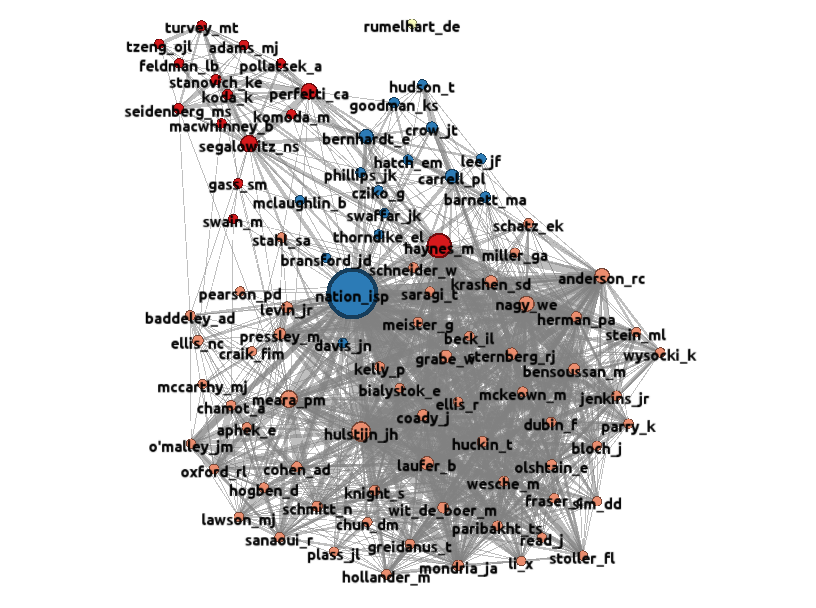
_lognostics maps:
The Modern Language Journal 1980-2010

data source: The Modern Language Journal 1980-2010: data analysis: April 2014
data: 56 papers, 92 nodes, 1025 co-citations, 4 clusters
threshold for inclusion: Authors must be cited in at least five different papers.
This map displays the vocabulary related papers published in The Modern Language Journal between 1980 and 2010.
92 authors are cited in at least five papers in this data. The nodes in this map are sized by betweenness centrality.
The two dominating figures here are Nation and Haynes.
Four clusters are identified in this data.
Cluster I is the large cluster at the foot of the map. This cluster includes over half of the 92 sources, including nearly all the most heavily linked sources. This cluster seems to represent main-stream research on the acquisition and teaching of L2 vocabulary. The members of this cluster are: NC Ellis, Wit-de Boer, Stahl, GA Miller, Bensoussan, Olshtain, Bialystok, Stein, Kelly, Stoller, Huckin, Herman, Krashen, Levin, Plass, Baddeley, Sim, Hulstijn, Wysocki, Parry, Oxford, RC Anderson, Chamot, Lawson, Schatz, Aphek, Jenkins, Bloch, Craik, Saragi, Meister, Knight, Hollander, Coady, MJ Mccarthy, Fraser, Pearson, Wesche, Paribakht, Hogben, Nagy, Li, McKeown, Grabe, Chun, Read, Laufer, Schmitt, Meara, Beck, Dubin, Cohen, Sternberg, Greidanus, Pressley, Ellis, O'Malley, Mondria, Sanaoui and Schneider. This cluster contains some identifiable subgroups, notably a group concerned with memory for L2 words, a small group that deals with glosses and inferencing skills, and another small cluster dealing with the breadth/depth distinction in vocabulary testing. Particularly noticeable in this cluster is a group of sources whose work appeared in two books edited by Coady and colleagues in 1993 and 1997 respectively.
Cluster II, containing 15 members, is the smaller cluster in the centre of the map. This cluster contains a number of sources who were particularly active in the 1980s. The cluster seems to be mainly concerned with global L2 reading skills, but this work is anly rarely cited alongside more recent publications in this area. The members of this cluster are: McLaughlin, Bernhardt, Bransford, Hudson, Philips, Cziko, Lee, Thorndike, Hatch, Swaffar, Crow, Davis, Barnett, Carrell and Goodman. Nation is formally attached to this cluster, but he actually has close links with all the other clusters, unlike most of the other members of this group.
Cluster III, also containing 15 members, is the smaller cluster in the top left corner of the map. The principal influence in this cluster is Haynes, who plays an important role linking this cluster to cluster I. The cluster also includes a number of psychologists whose work has informed research on L2 vocabulary acquisition, specifically the mechanics of L2 reading skills, and the processes of comprehension in reading. The group includes: Stanovich, Turvey, Komoda, Tzeng, Swain, Gass, Haynes, Seidenberg, Koda, Segalowitz, Perfetti, Feldman, Macwhinney, Pollatsek and Adams.
Cluster IV contains only one member, Rumelhart, whose work on Information Theory and Cognitive Processing is sometimes cited in the context of L2 reading performance.
The 10 central figures in this map are Nation, Haynes, Hulstijn, Meara, Segalowitz, Perfetti, Nagy, RC Anderson, Bernhardt and Carrell.
points to note: This map is very different from some of the other maps in this series. The consensus around Nation, the relatively small number of co-citations joining Cluster I and Cluster III, and the consistent focus on L2 reading as a central theme are particularly striking. So too is the emergence of Haynes as a central figure. The map shows a very high level of consensus compared to the other maps: Nation and Haynes totally dominate this map, whereas in other maps the group of central figures tends to be made up five or six equally important sources. However, the pattern of co-citations within cluster I suggests that this consensus may be weaker than it appears to be. In particular, the sources on the left hand edge of Cluster I seem to be less strongly linked with each other than is the case in the rest of this cluster. The absence of any cluster that deals with corpus linguistics and the limited impact of research outside North America are also features that are worth noting in this map.